Possible Implications of the Ukrainian War on the Status of Bitcoin and the Global Economy
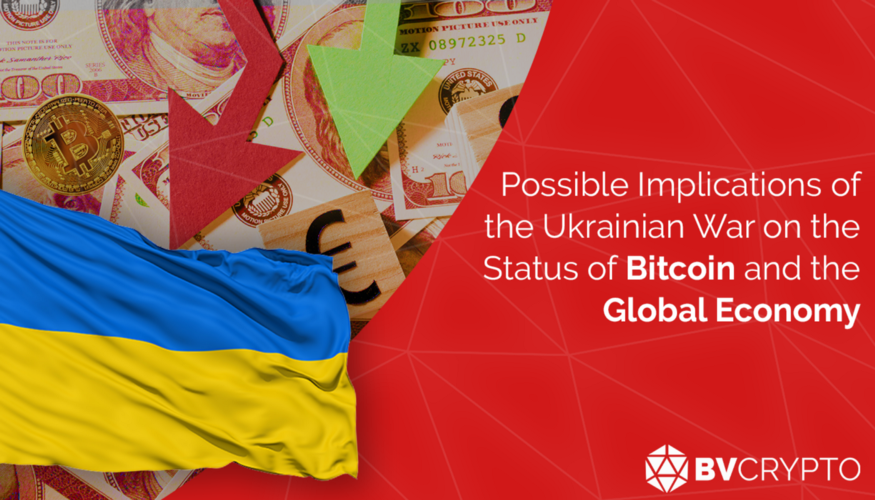
In any subject, global breakdowns change global systems. Otherwise, the cost of a country’s decision to change a global system would be very high. Therefore, countries must either divide the cost by demanding changes together or it should become inevitable to bear high costs for the country. Russia’s exclusion from global economic mechanisms following its military operation in Ukraine started to force Russia to the second option, where it has to bear the cost. The sanctions imposed on Russian banks and oligarchs were designed to continue the oil and natural gas trade. In the next stage, it was seen that the steps that may lead to a global crisis started to be taken with the expectations of the US to restrict the oil trade, freezing the reserves of the Russian Central Bank, and preventing Russia from using the Visa-Mastercard systems. There is probably no better example of a global breakdown than a global economic crisis. Therefore, a serious change in economic systems may take place due to the crisis in Ukraine and much different consequences than the 2008 crisis may occur.
In this article, after briefly discussing why the sanctions imposed on Russia may trigger a crisis, we will take a look at various ideas about why cryptocurrency can be an important opportunity as an alternative solution.
Monetary Policies
The economic problems due to the coronavirus pandemic for nearly 2 years have been attempted to be overcome smoothly by the central banks, pushing the limits of their monetary expansion policies. Today, although the coronavirus pandemic started to gradually lose its effect, its economic impact still continues. As a result of massive monetary expansions, especially that of the FED, a global inflation problem has emerged all over the world, including developed countries. With the normalization of trade, central banks started to increase interest rates by gradually reducing security purchases to take inflation under control.
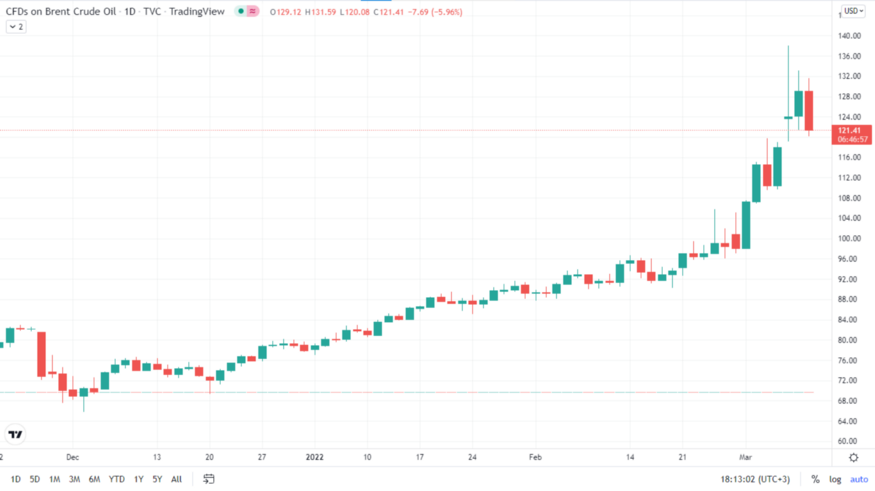
After the sanctions imposed on Russia, the lack of supply and problems in logistics, especially in energy sector, directly affected electricity and industrial production, causing the inflation to rise even more. At this point, central banks can be expected to resort to tougher monetary policies. However, if the economic embargo imposed on Russia disrupts the balance of payments and creates deeper crises, it may be difficult for central banks to follow monetary tightening policies. In this case, the method to be chosen is quite critical.
If central banks follow monetary expansion policies again, the purchasing power of money, which is already severely damaged, can be expected to suffer even more. If the monetary tightening policy is not dropped, organizations that are seen as indestructible, unsinkable, or in other words called ’too big to fail’, will be sacrificed due to lack of sufficient resources. In this case, unlike the soft transition after the 2008 crisis, there may be a much tougher transition in the future.
As long as Russia’s military operation in Ukraine continues, while getting closer to the negative effects of these two options, ending the operation as soon as possible and softening the sanctions seem to be the most efficient way in order to overcome this crisis with least damage possible. However, when the current policies of the countries are examined, it is seen that neither side intends to withdraw.
Untouchability
Russia got ahead of Iran very quickly in becoming the world’s most sanctioned country. Apart from Russia’s assets abroad, the use of USD and Euro in the reserve of USD 650 billion in the central bank’s vault has been banned. Russia aimed to protect itself from the effects of such sanctions by reducing the amount of USD, which accounted for 43% of its reserve in 2014, to 16% in 2022. However, this sanction imposed on the Central Bank of Russia raised the question whether keeping fiat money as reserve is effective. For the emergency use of reserves, it is also very important that the assets in the reserves cannot be blocked, in addition to having a strong market recognized all over the world. Gold stands out as the most suitable asset with these features since it does not belong to any country. Nevertheless, even though it is a global asset/commodity, gold cannot be considered a currency. For example, the untouchability of gold was not a solution to this problem when Mastercard and Visa prevented Russian citizens from using their own cards for payments outside of Russia. At this point, Bitcoin’s untouchability gives it a significant advantage over gold not only as an reserve asset, but also as a payment method. Since Bitcoin is an asset that does not belong to any country, has limited supply like gold, maintains its value in the long term, and is as easy to use as fiat currencies such as USD and Euro, it may have an important role during the crisis resulting from the Ukrainian war. The following tweet, in which Senator Warren expressed concern that Russia might use cryptocurrencies to evade sanctions, is a good example regarding the immunity of cryptocurrencies.
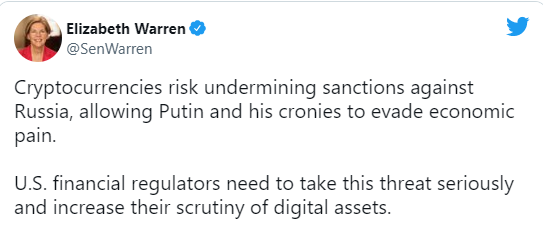
At the beginning of the article, we mentioned that the cost to change a global system would be high for a country and that Russia is starting to be forced to pay this cost. Although efforts have long been underway to ensure that Bitcoin is both used in daily payments and accepted as a reserve, the initiation of this process became possible only with a global breakdown, the Ukrainian crisis.
Guarantee
The low or high risk premiums of countries affect all of the macro indicators as they determine how much that country can borrow. The low premium is related to the trust in international markets. In order to build trust, apart from the rationality of the country’s economic policies, the assets in the reserves should also be shown as collateral. For this reason, many countries aim to increase trust in their markets by storing some of their gold reserves in hub countries such as the UK and the US. The reason that this system, which has become quite primitive both politically and economically, still continues is that gold has high transportation and storage costs. It has been the case many times that countries that do not agree politically with the US or the EU have transported their gold to their own country in order to avoid sanctions. Therefore, it is clearly seen that an innovative approach that can build trust is needed.
Tokenization-CBDC-Swift
Although the emergence of Bitcoin as global collateral is optimal, it should be kept in mind that Bitcoin is not mature enough to support such a transformation. Therefore, it can be argued that the first issue is to reduce the cost of gold but also to maintain the guarantee feature.
Trust is gained through smart contracts, especially for cryptocurrencies. The high security levels of the blockchain networks allow two parties to make mutual transactions safely by preventing any changes in wallet balances and assets in smart contracts or withdrawals of the collateral. A similar system for gold can only be possible by tokenization of gold. In this way, while the tokens representing the gold reserves can be safely transferred between countries, at the same time, smart contract systems suitable for these tokens can be created to be used as collateral. In this way, the current collateral system can be sustainable without keeping gold in hub countries such as the UK or the US. If countries cannot pay their debts, tokens can be automatically transferred to the lender, making this system trustworthy.
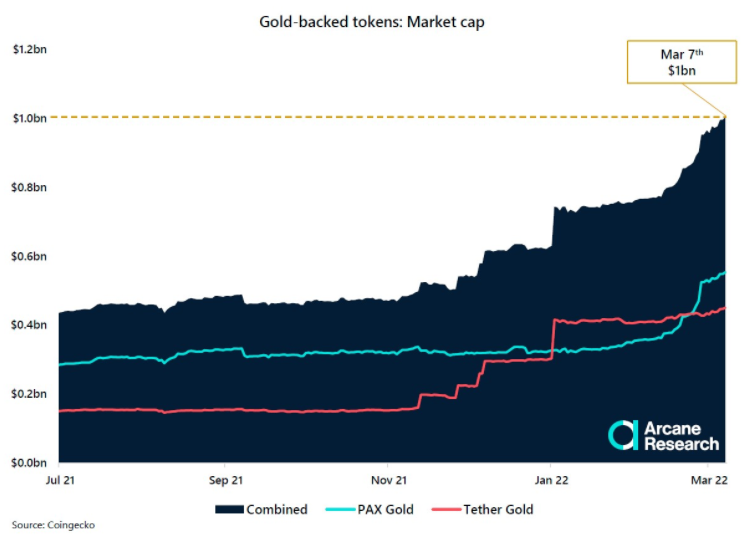
Since tokenized gold will facilitate the use of gold for exchange in trade, the current global currency status of the USD may be shaken. For example, it is known that countries need a common currency because it is not efficient to trade in local currencies. In this case, while the countries’ preference is usually USD, gold can be preferred instead of USD through tokenization. At this point, the role of Central Bank Digital Currency (CBDC) is also very important for this new system.
Central banks started to test blockchain-like networks and smart contracts through CBDC. Since more than 100 central banks have already developed CBDC, it can be said that the foundation of the new playground has been laid. The fact that countries are stuck in the bureaucracy of systems such as Swift, especially in large amounts of international money transfers, increases the attractiveness of CBDCs. Thanks to CBDCs, countries will also be more likely to trade in their local currencies. For example, in a trade between India and Russia, the payment in Digital Rupee (CBDC) is first converted into tokenized gold, then the tokenized gold can be credited to the account in Digital Rubles.
It is also important to remember the role of NFTs in this picture. The applicability of NFTs to all kinds of physical and digital objects has accelerated tokenization. Tokenization experiments continue not only in the field of art and games, but also in the field of finance. Finally, Santander Bank issued a token called Agrotoken, which represents farmers’ products, and developed a system that allows farmers to borrow their products by showing them as collateral. In the current system, there are also tokens that represent stocks.
As a result, while tokenization of all kinds of assets, including gold and fiat coins, is possible, the establishment of a new trading system in which all these tokens can work together may make systems such as Swift old-fashioned and lead to a breakdown in the status of the USD.
New Playground
The new playground created through CBDCs is undergoing many changes for various reasons discussed above. China’s early development and integration of the Digital Yuan into almost all payment systems in the country has led other countries to accelerate their initiatives in this area. The United States, which wants the dominance of USD in the current economy to continue, is one of the countries that is on the way with the Digital Dollar. In the Executive Order by President Biden, it is seen that the US adopts an innovative approach, rather than a prohibitive approach, to digital assets. The Executive Order summarizes the US view on CBDC and stable currencies, especially the section on the insufficiency of international money transfers in meeting the needs of consumers and the importance of digital assets in this sense.

In addition to the Order, US Treasury Secretary Yellen’s statement that the ministry is working to determine the rules of the new playground can be seen as a move by the US against China to take control in this area.

On the other hand, while Indian Economy Minister Nirmala Sitharaman explains that the country’s CBDC project may launch earlier than expected, it should be kept in mind that Dubai aims to create regulations suitable for the needs of the sector by cooperating with Binance and to start initiatives in this field together.
Mining
We talked about the prominence of local currencies in global trade with the CBDC transformation, and in this system, the common currency and reserve status of gold can be maintained through tokenization. The fact that gold is the preferable option for a smooth transition is not an obstacle for Bitcoin to reach a reserve asset status in this system. Bitcoin’s increasing market volume strengthens this possibility with each passing year. One of the most important developments for Bitcoin to reach a reserve asset status is the steps taken by countries in the field of cryptocurrency mining. Russia, which has become the most sanctioned country, can use it in foreign trade by purchasing the Bitcoins produced by the miners in the country, as happened in Iran, which was the most sanctioned country before the Ukrainian war.
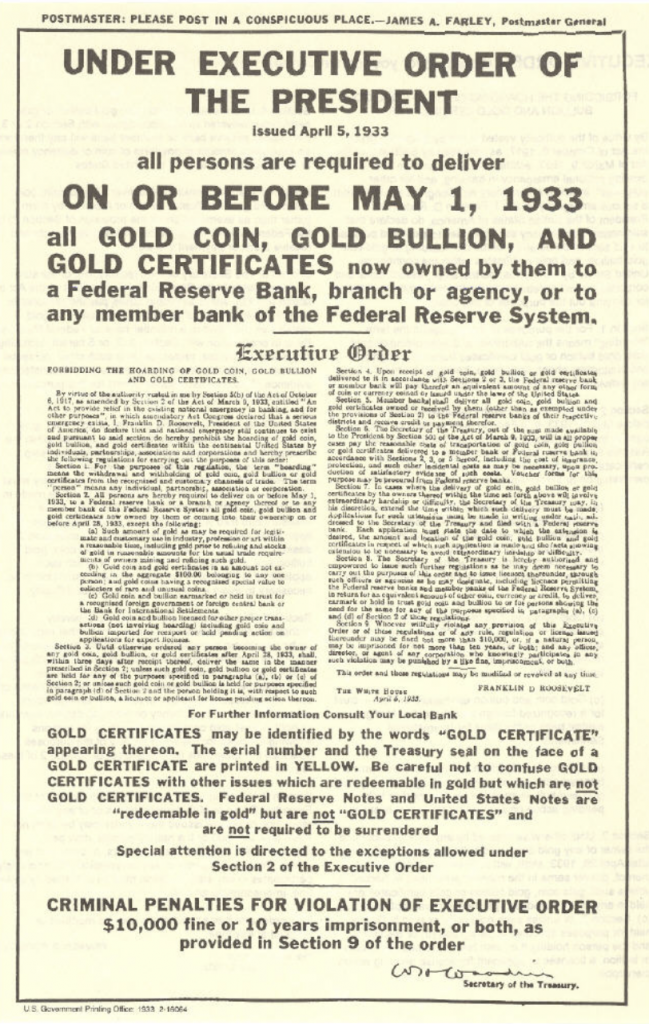
This practice, which can be called the modern version of the US’s call for people to hand over their gold to the Fed in 1933, may result in Bitcoin becoming widespread for a similar purpose today as it was used to strengthen the guarantees at that time.
In addition, it should not be forgotten that El Salvador received a loan of 1 billion USD from the market with BTC-based bonds, which it could not get from the IMF. Countries that want to avoid tough negotiations to get loans from the IMF, mitigate the damage of sanctions, or cannot overcome the inflation problem are likely to demand more BTC with the increase in the number of examples such as El Salvador. Finally, factors such as the Swiss city of Lugano de-facto cooperating with Tether to use BTC in daily payments and states in the US accepting BTC in payments such as taxes and invoices are other factors that support BTC’s reserve money status more or less.
From BV Crypto
In this article, we have listed the possible reasons and consequences for the popularization of a new CBDC-oriented economic model among states by mentioning the domino effect that may occur due to the Ukrainian crisis. Whether or not the Ukrainian crisis spreads over a long period of time, such a transformation is expected to take place sooner or later. Therefore, as BV Crypto, we would like to point out that we are aware that human life is more valuable than the economic breakdowns that war can bring, and we would like to underline that we are in favor of ending the war as soon as possible.
Prepared By: Berkay Aybey
The opinions and comments expressed here belong to BV Crypto. BV Crypto cannot be held responsible for any financial transactions made on the basis of this post. Every investment and trading move involves risk. When making your decision, you should do your own research.